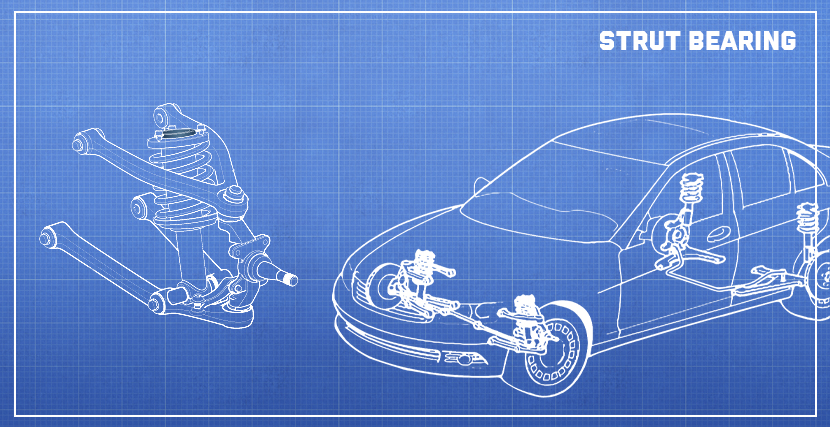Strut Bearing
Unlike your rear wheels that are always angled straightforward, the front wheels change their direction a lot of times while you’re driving. Since your front suspension is attached to the wheels, virtually all front suspension components must also turn with the front wheels. To ensure that, the front struts are attached to the vehicle’s body with the help of strut bearings. They allow the struts to spin around their center when you steer the vehicle.

The top of a front strut is bolted into a strut bearing, which, in turn, is attached to the vehicle’s body and secured with bolts. This front suspension arrangement allows for solving several essential tasks at the same time, such as holding the wheels in the correct position and making it possible to turn the wheels in different directions. In addition, suspension systems that utilize strut assemblies are more compact and lighter compared to their counterparts with leaf springs. This makes strut and bearing assemblies an ideal solution for compact and lightweight cars.
Strut bearings are an essential part of your front suspension. That’s why any problems related to their operation can affect your driving safety and put your life at risk. In the worst-case scenario, failed strut bearings can lead to a loss of control, and, therefore, cause an emergency situation on the road. The most common causes of strut bearing failures are aging, extreme temperatures and weather conditions, rust and corrosion, and road collisions. Fortunately, before your front strut bearings die out, you should notice some of the following warning signs:
- Abnormal noises when cornering or moving over a bump. This may include an array of noises, running the gamut from knocking and clunking to squeaking and rattling.
- Excessive vibrations you can feel through the steering wheel or seats
- Hard steering or binding
- Improper wheel alignment
- Excessive or uneven tire wear
- Damage to struts bearings at the mounting points
Strut bearing replacement and troubleshooting
Most strut bearings are maintenance-free parts that do not require your attention until they fail. When this happens, bad strut bearings must be replaced with new parts. Replacing strut bearings always involves a lot of labor since your struts must be disassembled and then reinstalled. Plus, a four-wheel alignment must be done after each and every strut or strut bearing replacement. That’s why it is a good idea to replace both struts and bearings at the same time.
Replacing a strut bearing is a complex job, so it should be done by a professional. Your mechanic will need to remove your struts first, and only then take off bad strut bearings from the assemblies. Both strut bearings should be replaced at the same time even if the only one is faulty. Besides, you should replace your strut bearings if the struts are replaced. In most cases, a four-wheel alignment is also required after each and every strut or strut bearing installation.
The strut bearings are crucial for the proper operation of your vehicle’s suspension system, which is why you should leave their replacement to a professional. He or she has all necessary equipment to remove your strut bearings without running the risk of getting injury. This is very important because the coil springs in the strut assemblies are under a huge amount of pressure, so they must be removed with special tools that will keep the spring tension under control.